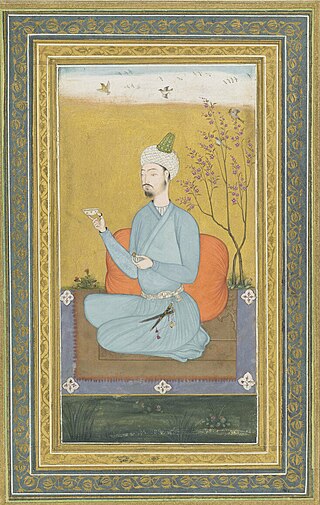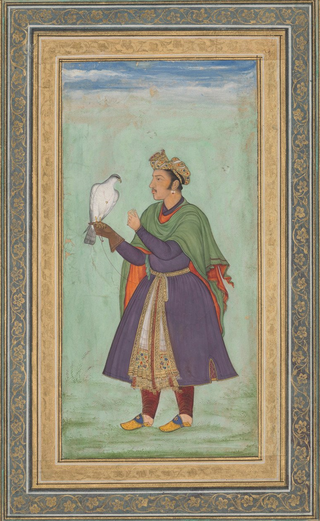
Nasir al-Din Muhammad, commonly known by his regnal name Humayun, was the second Mughal emperor, who ruled over territory in what is now Eastern Afghanistan, Bangladesh, Northern India, and Pakistan from 1530 to 1540 and again from 1555 to his death in 1556. At the time of his death, the Mughal Empire spanned almost one million square kilometers.

Kamran Mirza was the second son of Babur, the founder of the Mughal Empire and the first Mughal Emperor. Kamran Mirza was born in Kabul to Babur's wife Gulrukh Begum. He was half-brother to Babur's eldest son Humayun, who would go on and inherit the Mughal throne, but he was full-brother to Babur's third son, Askari. A divan written in Persian and Chagatai is attributed to him.

Gulbadan Begum was a Mughal princess and the daughter of Emperor Babur, the founder of the Mughal Empire.

Khusrau Mirza was the eldest son of the Mughal Emperor Jahangir and his first wife, Shah Begum. The young prince displayed exceptional skills and wisdom and had the privilege to be groomed by the Mughal Emperor (Akbar) himself for the throne of the Mughal Empire. He turned out to be the most capable and qualified son of Jahangir but was befallen by an unfortunate destiny. Being Jahangir's eldest son, he was the heir-apparent to his father but Jahangir favoured his son Khurram Mirza as he held an animosity against Khusrau.

Hamida Banu Begum was the empress consort of the second Mughal emperor Humayun and the mother of his successor, the third Mughal emperor Akbar. She was bestowed the title of Mariam Makani, by her son, Akbar. She also bore the title of Padshah Begum during the reign of Akbar.

Munʿim Khān was a Mughal general under both emperors Humayun and Akbar. He was titled Khān-i-Khānān when Emperor Akbar appointed him as Prime Minister of the Mughal Empire in 1560. In 1564, he became the Subahdar of Jaunpur. Munim Khan was the first Mughal governor of Bengal Subah from 1574 to 1575 and Kabul in two separate terms from 1556 to 1560 and 1563 to 1575.
Begum is a female title which is also used in Mirza families/lineages, Daughter of Beg or Wife of Beg, a given name and surname.

Shahzada Mirza Muhammad Hakim, sometimes known simply as Mirza Hakim, was the third son of the Mughal emperor Humayun. He ruled Kabul in Afghanistan, and often conflicted with his elder brother, Emperor Akbar. Mirza Hakim later on mended ways with Emperor Akbar. He is the son of Mah Chuchak Begum. Akbar by his half-brother, Mirza Muhammad Hakim, the ruler ef Kabul, who was practically independent, although supposed to owe fealty to the emperor of India.
Ruqaiya Sultan Begum was the first wife and one of the chief consorts of the third Mughal emperor, Akbar.

Salima Sultan Begum was the third wife and chief consort of the Mughal emperor Akbar, and the granddaughter of Babur.

Khanzada Begum was a Timurid princess and the eldest daughter of Umar Shaikh Mirza II, the amir of Ferghana. She was also the elder sister of Babur, the founder of the Mughal Empire. She and her brother remained deeply attached to each other all their lives, a period during which the family progressed from ruling a tiny and obscure principality in Central Asia to ruling a large portion of the Indian subcontinent. Babur conferred on his sister, the honorable title of Padshah Begum and she was really the first lady of his Empire after his death.
Bakshi Banu Begum was a Mughal princess and was the second daughter of Emperor Humayun and his consort Gunwar Bibi. Bakshi Banu was thus the older half-sister of the Mughal Emperor Akbar.
Mihr Nigar Khanum was the first wife of Sultan Ahmed Mirza, the King of Samarkand and Bukhara. She was a princess of Moghulistan by birth and was the eldest daughter of Yunus Khan, the Great Khan of Moghulistan and his chief consort Aisan Daulat Begum. She was also the aunt of Emperor Babur, the founder of the Mughal Empire of India as well as its first Emperor.
Nur-un-Nissa Begum meaning 'Light among Women', was a Timurid princess, the daughter of Ibrahim Husain Mirza and the wife of fourth Mughal emperor Jahangir.
Sakina Banu Begum was a Mughal princess, the daughter of Mughal emperor Humayun.
Bakht-un-Nissa Begum was a Mughal princess, the daughter of the Mughal emperor Humayun.
Masuma Sultan Begum was a Mughal princess and the daughter of the first Mughal emperor, Babur. She is frequently mentioned in the Humayun-nama by her sister, Gulbadan Begum, who calls her sister 'Elder sister Moon'.
Shakr-un-Nissa Begum, also Shakr al-Nisa Begum was a Mughal princess, the daughter of Emperor Akbar.
Sultan-un-Nissa Begum was a Mughal princess, the eldest child and first daughter of Mughal Emperor Jahangir from his first wife, Shah Begum.
Shahzadi Khanam was a Mughal princess, the second surviving child and eldest daughter of Mughal Emperor Akbar.








